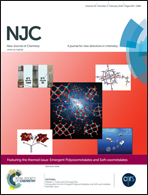Complexation of Hg2+, CH3Hg+, Sn2+ and (CH3)2Sn2+ with phosphonic NTA derivatives
Abstract
The complex formation between Hg2+, CH3Hg+, Sn2+ and (CH3)2Sn2+ with some phosphonic derivatives of nitrilotriacetic acid (NTA), namely N-(phosphonomethyl)iminodiacetic acid (PMIDA, NTAP), N,N-bis(phosphonomethyl)glycine (NTA2P) and [bis(phosphonomethyl)amino]methylphosphonic acid (NTA3P), has been studied using potentiometry in NaCl aqueous solution at I = 0.1 mol L−1 and T = 298.15 K. In order to evaluate the possible use of these ligands as sequestering agents towards the above-cited cations, some selected systems have been investigated at different ionic strengths, for a better modelling of their speciation and their binding ability in real conditions. For the same reason, the protonation enthalpy changes of the three chelants have been determined by direct calorimetric titrations, in order to define their acid–base behaviour at different temperatures. The results obtained have been compared with the literature data on NTA complexes in order to evaluate and model the effect of the number of carboxylic and/or phosphonic groups of the ligands towards their efficacy in the chelation of the investigated cations. To this aim, the stability constants of NTA with Sn2+ have also been determined here for the first time, since, to our knowledge, this system has never been investigated before.


 Please wait while we load your content...
Please wait while we load your content...